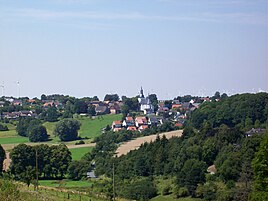Altenrüthen
|
Altenrüthen
City of Rüthen
|
|
|---|---|
| Coordinates: 51 ° 29 ′ 48 ″ N , 8 ° 24 ′ 17 ″ E | |
| Height : | 338 m |
| Residents : | 511 (December 31, 2014) |
| Incorporation : | 1st January 1975 |
| Postal code : | 59602 |
| Area code : | 02952 |
|
Altenrüthen
|
|
Altenrüthen is a district of the city of Rüthen in the Soest district . On December 31, 2014 the village had 511 inhabitants.
location
Altenrüthen is located northwest of Rüthen. The area is 6.94 km². In 1975 there were 85 inhabitants per square kilometer here.
history
The main farm Rüden near Altenrüthen, which no longer exists today, was the ancestral seat of the medieval aristocratic family of Rüdenberger . The village was first mentioned in the ninth century in the provost register and also in the Corveyer traditions. In 1802 Altenrüthen became part of Hesse and in 1815 of Prussia. In 1816 the district of Altenrüthen became part of the new Lippstadt district. In 1828 the Altenrüthen district became the municipality of Altenrüthen. A few years later the Altenrüthen office was established with 16 communities. In the 1930s, the Rüthen office was formed from the Altenrüthen office and the city of Rüthen. On January 1, 1975, the municipality of Altenrüthen was incorporated into the city of Rüthen.
Population development
- 1861: 357 inhabitants
- 1939: 372 inhabitants
- 1950: 612 inhabitants
- 1961: 500 inhabitants
- 1970: 484 inhabitants
- 1974: 588 inhabitants
- 1975: 588 inhabitants
- 2011: 520 inhabitants
- 2014: 511 inhabitants
Buildings and landmarks
The Catholic parish church of St. Gervasius and St. Protasius is characteristic of the site . The listed rectory is also worth seeing . The Way of the Cross at Altenrüthener Friedhof proves to be historically significant : Somewhat hidden, embedded on the inside of the southern churchyard wall , are lined up, interrupted by the above. Rectory, seven old stations of the cross next to each other. Designed in the same way, they represent, so to speak, a splendid edition of the typical baroque holy houses made of Rüthener green sandstone . "Their real significance as a monument lies in the religious peculiarity of this ensemble: It is a way of the cross in the original form of the so-called ' Seven Footfalls ' came up around 1500 as a forerunner of the later ways of the cross with fourteen stations. Ensembles in the form of the 'seven footfalls' are rarely found. The Altenrüthener group is unique in Westphalia , only in Bavaria is another way of the cross of this type known. "
literature
- Ulrich Grun : Way of the Cross on the Altenrüthener Friedhof , in: Kreis Soest (Ed.): Calendar of the Soest District , Soest 1990, ZDB -ID 619151-4 , p. 32
Individual evidence
- ↑ Stadt & Tourismus> Ortsteile , accessed on May 17, 2016
- ↑ Albert Ludorff : The architectural and art monuments of Westphalia, published by the Provinzial-Verbande der Provinz Westfalen Kreis Lippstadt, 1905, page 11
- ^ Federal Statistical Office (ed.): Historical municipality directory for the Federal Republic of Germany. Name, border and key number changes in municipalities, counties and administrative districts from May 27, 1970 to December 31, 1982 . W. Kohlhammer, Stuttgart / Mainz 1983, ISBN 3-17-003263-1 , p. 335 .
- ↑ Ulrich Grun: Way of the Cross on the Altenrüthener Friedhof . In: District of Soest (ed.): Calendar of the district of Soest . 1990, ZDB -ID 619151-4 , p. 32 .



